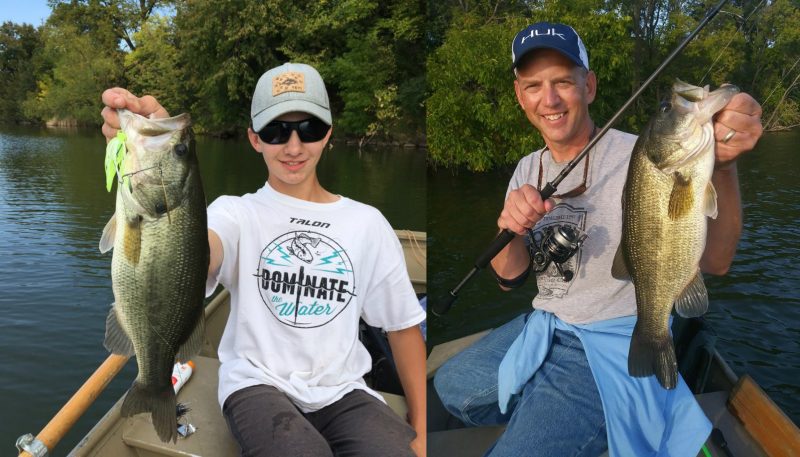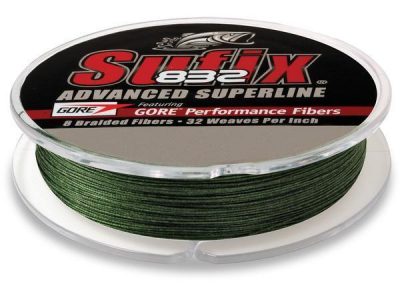Terminator Popping Frog + Titanium Spinnerbait = Best Day for Big Bass
Dave Maas 09.15.17

Fact: I own a decent amount of fishing tackle, but I’ve never been one of those anglers who spends a lot of time on the water digging in their tackleboxes, changing lures and experimenting. Sometimes my “I’ll make them eat a Texas-rigged worm” attitude works, but I think in hindsight, I’d probably do better by having a bit more of an open mind.
Case in point: This past Saturday, my 14-year-old son, Elliott (photo above), had his best single day of bass fishing in his young life. I can take pride in the fact that I was guiding him, which is to say I ran the trolling motor as we fished from my 12-foot johnboat. He still decided on where we should go. And while he doesn’t tell me what I should use when it comes to lures, I often have advice for him because, well . . . I’m a know-it-all-father. Thankfully, he’s a smart kid and can make decisions for himself, and on this day, he decided to throw a Terminator T-1 Original Titanium Spinnerbait along the shoreline, while I stubbornly jigged a weedless worm.
Long story short, he kicked my butt from noon to 6 pm on the shallow-water lake. I’d like to blame it on the fact that he was getting first water, but in all honesty, I think the bass preferred a bit faster presentation that afternoon.

Which brings us to the evening bite, 6 to 7:30 pm. I grabbed a frog rod and on my second cast lost a decent-size bass on the edge of a lily pad field.
“Nice try, Dad,” Elliott laughed. You see, he’s been fishing a lot more than me this summer, and my hookset timing with topwater frogs is a bit rusty. “Let me show you how it’s done.”
I smiled, shook my head, then handed him the froggin’ rod. Moments later, I was taking pictures of a 21-inch largemouth (4 pounds, 6 ounces) in his grip (photo below).

For the remainder of the evening, I didn’t even cast. Instead, I spent time enjoying the setting sun and watching Elliott fish. Because it was too weedy to quietly move with the trolling motor, I slowly rowed our boat into position so he could hit the likely holes with his frog.

Now, about this particular Terminator Popping Frog: Up until that evening, Elliott had never been a big fan of popping-style frogs. “I’ve caught bass on them,” he said prior to landing the 21-incher, “but they’ve all been pretty small. I guess I like walking-style frogs better.”
Certainly, the 4-plus pounder had opened Elliott’s mind to the possibilities of catching big bass on popping-style frogs. “I like them in dirty water,” I offered when handing over the froggin’ rod. “You have to fish them just a touch slower, but at times I think they call up bass better than a walking frog.”
Sidebar: To this point in Elliott’s bass career, he’d caught numbers of 4-pound bass, but cracking the 5-pound mark had been a challenge. He caught two bass weighing 5 pounds last winter, but because those fish were “accidents” while targeting panfish and northern pike, he really wanted to catch a 5-pounder on open water while specifically fishing for bass.

A note about exact fish weight, too: A year ago my wife and I bought Elliott a Rapala 50-Pound Touch Screen Scale. I had it in my mind that a 20.5-inch largemouth, assuming it’s not skinny, weighs 5 pounds, and a 21-incher (again, assuming it’s not skinny) is over 5, maybe 5.5 pounds. But I’ve never owned a high-quality scale.
Well, Elliott’s scale is super accurate — we’ve tested it several times on exercise weights and other items around the house — and the numbers don’t lie. Elliott has caught a handful of 20-inch largemouths this summer, and they all weighed 4 pounds and change. His 21-incher from this day weighed 4 pounds, 6 ounces. He caught another 21-incher on a solo trip that tipped the scale at 4 pounds, 11 ounces. Yes, cracking the 5-pound mark on an accurate scale isn’t easy — at least in our home state of Minnesota.

Elliott was still excited about his 21-incher when he had a massive strike at the end of a cast. It was one of those times when the bass leaves the water while trying to KILL the frog. I know I would’ve swung too soon and missed, but Elliott actually said the word “Giant!” before setting the hook.
Like so often happens with fat bass in skinny water, the water just boiled at the edge of the slop. The fish wasn’t taking drag, but Elliott wasn’t gaining any ground, either. The big bass broke the surface again, and I grabbed for the net. The battle was short but violent.
As Elliott grabbed the fish from the net, I said, “Buddy, I think this one might go 5.”
Elliott, knowing that it’s easy to overestimate fish weight, played it cool: “I hope you’re right. Let’s see what the scale says.”
“5 pounds, 13 ounces!” he exclaimed. “This one smashes the 5-pound mark! And get this, Dad: Our five-fish bag now weighs 21.3 pounds!” (Elliott’s digital scale has a feature that allows him to tally his five biggest bass for a day.)

Of course, I was happy to share in Elliott’s excitement — and just spending time on the water with him is always the best, regardless of whether the fish are biting.
I’m sure this is just one of many trophy bass Elliott will catch in his lifetime. But no matter how many he lands in the future, his first open-water 5-plus pounder will always be special.

P.S. Froggin’ Gear Specifics: Elliott was using my well-worn 7-foot, 3-inch St. Croix Avid casting rod (above). This medium-heavy power, fast-action rod with telescoping handle — think old-school flippin’ stick — isn’t made anymore, but it does a good job with frogs. (For Christmas this year, I plan on putting a 7-foot, 4-inch, St. Croix Mojo Bass Slop-N-Frog rod (MJC74HF) under the tree with Elliott’s name on it.) My St. Croix is matched with Shimano Curado baitcaster and 65-pound Sufix 832 Advanced Superline. With this rig, we can throw the Terminator Popping Frog an amazingly long distance and reach far-away pockets in the slop. It’s a deadly system.


